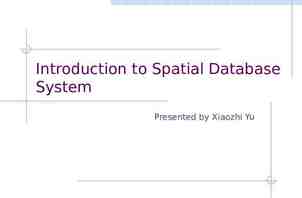Managing Return to Work Supervisors 1
88 Slides4.52 MB

Managing Return to Work Supervisors 1

Housekeeping Please turn all mobiles and pagers off Please place all rubbish in the bin before you leave today Please treat each other with respect What we say in this room stays in this room Participate! 2

Agenda for today 9.00 Commencement Your role as a supervisor Returning to Work Workforce Reintegration 10.30 – 10.45 Morning Tea Understanding musculoskeletal pain & discomfort 1.00 – 1.30 Lunch Communicating with workers about pain and injury 3.00 – 3.15 Afternoon Tea Ergonomic principles Problem solving 5.00 Conclusion of session 3

Learning Objectives By the completion of this session, you will be able to: Identify problems and benefits associated with both effective and ineffective return to work programs Demonstrate knowledge of variable courses of recovery Demonstrate the importance of effective reintegration to the workplace Identify factors that may suggest when a reintegration may be a concern. Identify factors that impede and assist employees with musculoskeletal problems 4

Learning Objectives (Cont.) Demonstrate knowledge of the key elements of effective communication and any barriers that impede success Identify when issues should be referred or further assistance sought Identify additional tools available Identify members of the Return to Work team When further assistance should be sought Demonstrate knowledge of ergonomic principles and their value in the workplace Demonstrate the use of a problem solving approach 5

Your role as a supervisor Your role as a supervisor to develop employees and monitor their performance puts you in a pivotal position to observe changes in behaviour and the emergence of physical, mental and personal problems. As a supervisor, you are also held responsible for getting the job done, and for doing so safely, effectively and efficiently. Early recognition of problems, intervention and support during the early stages of treatment are keys to achieving effective results. 6

The current situation Research shows that many supervisors dealing with workplace illnesses and injuries feel: Helpless and confused in the role as a supervisor Angry or frustrated Fearful or uncomfortable about handling personal problems in the workplace Guilt Fear confrontation, criticism or losing control Uncertain of how they are handling the situation Uncertain of how to communicate about personal issues with the employee They are taking on other people’s problems as their own The degree of personal emotions involved Frustrated at trying to balance employee needs with the demands of time pressures, service standards and management expectations. 7

How this course will assist you Today’s session will enable you to become familiar with different approaches and problem solving techniques in dealing with issues that you may be experiencing in your roles as supervisors. 8

6 Step Plan to Integration As we progress through today, you will be able to work through each part of a 6 step plan, designed to assist you with reintegration. Reintegrate Observe Introduce Refer Confront Document

What is a Return to Work Program? It is a collaborative, proactive process that we use to help injured workers stay at work or return to productive and safe employment as soon as physically possible. They are based on the philosophy that many injured employees are capable of making a positive contribution in a safe workplace, during the recovery process. Returning to work is seen as a critical part of the therapy and recovery of the employee. 10

What information should be contained in a Return to Work plan? It should clarify the employee’s medical restrictions It should match the employee’s physical capacity for work, to the job demands Provide suitable duties and hours for the employee to follow Should clearly detail how the program will operate Contain approval from the employee’s treating doctor of the Return to Work plan 11

What information should be contained in a Return to Work plan? Should state that regular monitoring will take place Be consistent with the business goals of the department or area the employee is returning to Specify that a gradual increase in both hours and duties will occur, until a return to full duties or alternate employment is achieved Detail where the employee can obtain additional help Respect the employee’s dignity, privacy of personal information and confidentiality of personal health details. 12

Key elements for a successful Return to Work All elements need to be in place for Return to Work plans to stand the best chance of assisting an employee to make a sustained return to their pre injury or alternate full duties. Progressive safety and rehabilitation compensation legislation Incentive driven system Effective RTW Plan Skilled Injury Management Sense of control Knowledge of injury Proactive case management Employee feels valued Supportive Workplace Culture Ongoing employment options Cooperative workplace relations Commitment to Action Employee feels valued

What actions do the employer and employee have to take? Each state and country has differing legislative requirements regarding obligations that both the employer and employee must meet regarding safety in the work place and any injuries or illness that arise. In general these are: The employer is required to take all appropriate steps to ensure that the workplace is as safe a working environment as is possible. Employees have a duty of care to ensure that they work in a manner that is not harmful to their own health and safety and the health and safety of others. Injuries or illnesses must be reported to an appropriately authorized person within the company. 14

What does an effective Return to Work mean? The program should be tailored to the employee needs and be coordinated accountable and results focused The employee should be actively involved in the development of the plan Return to Work Activity should commence as soon as possible after injury The employee’s workplace should be the focus of the rehabilitation program The employer should take preventative action

Benefits of an effective Return to Work Benefits to the employee: Confidence that appropriate support will be provided Greater certainty when returning to work, that they will be given suitable duties Feel that their work is valued They are needed and feel important Increase in reporting of problems (Atmosphere of trust) as they have a sense of being in control of their return to work Increased communication levels Acceptable level of employee contribution and collaboration 16

Benefits of an effective Return to Work Benefits to the employee: Results in an increased sense of loyalty to the employer Increases self esteem and minimizes possible feelings of guilt that they have been injured Promotes better morale amongst workers Provides the employee with the ability to maintain social contact with fellow employees Reduces the financial impact to the worker Provides the employee with the opportunity to retain job skills 17

Benefits of an effective Return to Work Benefits for the company: Team approach as business units and teams work together Staff feels cared for and supported positive morale Reduces the likelihood of fraudulent and/or malingering claims Saved indemnity expenses Cost saving on hiring and training replacement workers Receives some production for wages paid May speed healing and save additional medical expenses Reduces the cost in premium rates Probability of injuries or illness decreases Identification of training opportunities Identification of workflow improvements to generate efficiencies 18

Benefits of an effective Return to Work Benefits for you: Increased chance of meeting targets Promotes an increased sense of team Able to promote a supportive and positive culture Enables early intervention Greater understanding of the rehabilitation process Increased likelihood of positive performance review meetings with increased productivity Enhanced and demonstrated leadership role within the company Increased confidence and problem solving skills 19

Ineffective Return to Work Plans Consequences to the employee: Long term health problems Injured employees off work longer than six months have only a 50% chance of ever returning to their job. If this time exceeds one year, their chances decrease to 10% Delay of return to work greater than 3 weeks is associated with a reduced chance of returning to work. Isolation, depression, anxiety and fear Long term financial consequences Consequences for employees family Compensable injuries can take up to four times longer for recovery than non compensable injuries 20

Ineffective Return to Work plans Consequences to the company: Financial impact: Direct – Premium costs, first ten days of lost wages, H & S fines. Indirect – Supervisor time, HR costs, onboarding costs (recruitment costs, advertising costs, lower productivity during initial period of employment, reduced productivity of staff on modified or reduced hour duties. Impact on company morale Impact on company reputation 21

Ineffective Return to Work plans – Company cont. Most companies pay between 1-6% of payroll in compensation costs. These are the direct premium costs only. Indirect costs are thought to be as much as 4-10 times the direct costs. 93 percent of executives saw a relationship between the direct and indirect costs of a workplace incident. Indirect costs include the overtime, training and lost productivity related to an injured employee not being able to perform their normal work. 40 percent of managers reported that each 1 of direct costs generated between 3 and 5 of indirect costs. 22

The iceberg effect on the company DIRECT COSTS Incapacity payments for lost earnings Medical costs Rehabilitation costs Property damage INDIRECT COSTS Time lost lost productivity Loss of experience, skills and knowledge Cost of recruitment, replacement and training Increased workload pressure and uncertainty for co workers Higher risk to injuries to other staff and lowered morale Absenteeism, turnover, workplace conflict The cost of replacement equipment Damage to the organisation’s reputation as an attractive workplace 23

Ineffective Return to Work plans Consequences to the supervisor: Additional time commitment required in managing a Return to Work Reduced staffing levels Reduced flexibility in allocating work Frustration and demoralisation Not meeting work targets Additional time commitment required to managing individual team member’s behaviour, needs and expectations 24

Issues arising with Return to Work plans 90% of cases are straightforward and relatively uncomplicated, requiring a simple supportive approach. 10% of cases are more complex and require the following: Lateral thinking Greater time management Patience Emotional support Possible involvement of claims management staff. 25

Signals for more complex cases Some indicators that may be present when there is a complex case: Delayed reporting of the injury Previous performance issues Person with poor self efficacy Job security in jeopardy 26

Suitable Duties Suitable duties can best be described as the process of matching the employee capability, skill level and position with appropriate job tasks. Suitable duties are short-term work duties, agreed between the employer and the injured worker, to assist the injured worker’s rehabilitation. 27

Suitable Duties Must comply with a current medical certificate, and may include: Parts of the job the worker was doing before the injury The same job, but on reduced hours Different duties altogether Duties at a different site Training opportunities A combination of some or all the above. 28

Suitable Duties are not. Work that is merely of a token nature, that is not useful for your trade or business Work that is demeaning to the worker or has no employment prospects 29

A case study in motivation – Jason & Paul 30

Maslow’s Hierarchy of Needs Self Actualisation Ego (Esteem) Social / Belonging Safety / Security Physiological

Workplace Reintegration - Intervention There are several times when it is preferable that intervention occurs. Some of these are: Before an injury/accident occurs At the time the injury/illness is reported At the time the employee is hospitalised Over the first week that the employee is away from the workplace On the initial Return to Work day of the employee Over the first few weeks of the Return to Work implementation 32

Critical timings in Reintegration Why timing is so important: Medical and surgical treatment does not help injured or ill employees as much as non compensable injuries Employees are off work for longer periods The longer an individual is off work the less likely they are to return to work The longer someone is off work the greater the likelihood they will become depressed. Many suffer financial problems as a result of a reduced income Marriage or relationship breakdown is not an uncommon problem for people who are off work for long periods. 33

Key Elements in Reintegration Supportive and open communication Responsiveness Motivation Concise Return to Work plan Regular meetings with the employee Supportive co workers Positive workplace relations Regular follow up communication Resolution of other work issues Employee / Supervisor partnership Commitment of Senior Management 34

Reintegration – Michael’s story 35

Morning Tea 36

Musculoskeletal Pain and Discomfort What does the term “musculoskeletal pain” mean? We can best phrase it as pain originating within the muscle, joint and bone systems such as pain from arthritic conditions, painful muscle conditions, broken bones, torn ligaments and tendons and pain of spinal disc origin. 37

Sore Body Bits (SBB’s) Over 50% of the population has a long term Sore Body Bit Back, neck, shoulder, arm and knee problems are the most common SBBS Most problems are mild and bothersome rather than interfering with all activities Pain can be severe, particularly with back problems where there is muscle spasm present, or in the early stages of an injury or a problem SBBS can get better quickly or can take a long time to settle. 25% of new episodes of back pain can take up to 2 years to settle Most people with SBB’s find that they can return to a good level of functionality over a matter of days to weeks to months, depending on the condition and the treatment received 38

Sore Body Bits (SBB’s) – Back pain In any one year 10 percent of the community advises they have had an episode of back pain severe enough to significantly limit their activities About one in six people in the community has a long term back problem, aching most of the time and causing more substantial pain a few times each year In 1998/1999 the total cost of back injuries was 203 million and involved a time loss of 110,554 weeks Assuming that the composition of total costs has remained at a similar level since 2001–02, the total cost of work-related injury for the financial year 2005–06 would be at least 34.9b (based on an estimate of 7.8b in workers compensation payments to households in 2005–06) 39

Musculoskeletal Diagrams Pages 47-52 of your workbook display joints and parts of the musculoskeletal system that are the most commonly affected by injury Intervertebral Disc 40

Management of musculoskeletal back injuries Arrange return to work Exclude serious pathology Educate the patient and manage expectations Encourage light activity and self management Provide symptomatic pain relief

Measuring the frustration levels of injured employees – Sharon and Neville Sharon Neville 42

Factors contributing to frustration levels Medical investigations and treatments may provide limited benefit Treatment may not assist Explanations provided by treating practitioners may not answer all of their relevant questions Trials of one treatment after another not resulting in noticeable improvement Delays in accessing treatment, and approval being given for recommended procedures 43

Factors contributing to frustration levels Some SBB’s have well recognised treatments that help the problem quickly, however treatment for many SBB’s is of limited benefit is trial and error X-rays and scans are often unhelpful In compensable cases the usual system of the patient judging the ‘value’ of treatment is missing Treatment outcomes in compensable cases are worse Treating practitioners often use different words or diagnoses for the condition 44

Lunch 45

Communicating with workers The importance of communication Communication and coordination are key elements in a Return to Work program. Studies have shown that where regular contact is made between the supervisor and employee, the probability of a Return to Work increases substantially 46

Identifying key elements of communication Be approachable and responsive Use the acronym SOLER as a reminder – See Open Lean Eye Contact Relax . 47

Identifying key elements of communication Show genuine interest in the employee Active listening Paraphrase Ensure confidentiality is maintained Have specific follow up plans Reinforce positive behaviours Use effective questioning Make adaptations for gender, age, culture etc 48

Active listening Active listening intentionally focuses on who you are listening to, whether in a group or one-on-one, in order to understand what the other party is saying. As the listener, you should then be able to repeat back in your own words what they have said to their satisfaction. This does not mean you agree with, but rather understand, what they are saying. 49

Benefits of active listening Opens people up and encourages them to say more It forces you to listen attentively to others Avoids misunderstandings as people clarify what has been heard and understood

Irene – A Case Study 51

Barriers to effective communication Personal beliefs and feelings Time constraints and work demands Lack of support Fear and/or anxiety Cultural beliefs and values Perceptions Gender Age Education 52

Sphere of Influence It is important that we remember that pain and how we react to it is not determined solely on a physical basis. The following factors Come into play: Social Factors Physical Pain Illness Behaviour Attitudes and Beliefs Psychological Distress

The Arc of Distortion The Arc of Distortion is a term used to describe the variances between the message sent and the message received in a verbal interchange. The larger the arc, the greater the difficulty the receiver has in understanding the message as it was intended. Direct Line Sender Receiver Indirect Line 54

The Arc of Distortion Why does it occur? Age Culture Gender Group membership Education All of these factors can alter the words a person uses to express themselves 55

Face to face conversations Supervisor Spoken words “I’m keen for you to return to your original job as soon as possible” Employee The words heard by the employee with an arc in Place “I want you to stop faking it and get back to your normal job straight away. I’m not going to change anything for you” 56

Effective Questioning Effective questions are questions that are powerful and thought provoking. Effective questions are open-ended and not leading questions. They are not "why" questions, but rather "what" or "how" questions. Behind effective questioning is also the ability to listen to the answer and suspend judgment. This means being intent on understanding what the person who is talking is really saying. 57

The Benefits of Effective Questioning Establishes rapport Demonstrates that you care about the other party and are actively listening to them Develops a deeper understanding Enables control of the conversation flow Increased motivation to problem solve 58

Bill – A Short Story 59

Communication Activity 60

Why active communication needs to be maintained You have the biggest influence on the outcome of a Return to Work and successful reintegration You have the capacity to influence and determine workplace culture You can have a positive or negative impact on safety. When managers, supervisors and employees do not share beliefs about the importance of safety, inconsistent communications result. Research shows that employees pay attention to whatever management pays attention to. If employees constantly hear about the need to reduce costs, increase production and improve quality while hearing little or nothing about safety, they will focus, like management, on everything except safety. 61

The difficult or long term case Generally these tend to be claims that last in duration from one to three years in length. The employee may have made a number of attempts to return to work during this period, but has not been able to complete a sustained return to their pre injury employment. “The factors associated with protracted disability included low workplace support, personal stress, shorter job tenure, prior episodes, heavier occupations with no modified duty, delayed reporting, greater severity of pain, more significant functional impact and extreme symptom reports.” (2004) Disability Management, Return to Work and Treatment, Goldner, Bilsker, Gilbert, Myette, Corbiere, Dewa 62

Jill & Rob’s Stories 63

Events and factors of influence Often there are a number of events and factors happening concurrently with the injury or illness that the employee has suffered. As we have discussed previously, outside influences such as the family, the community, depression or anxiety, prior experiences with health professionals etc may all be present. Some of these may be: A fear of the workplace Motivation Other workplace issues 64

Available tools – What you can do Remember that you are not alone! Both within and external to your workplace are a number of people and tools that can assist you. Firstly you must identify what the issues are to determine which tool to use, and the best application of it. Often there are underlying factors influencing the employee’s frame of mind. 65

Available tools – What you can do What do employees want? Firstly, determine what you believe the employee needs or wants. Better communication and information More transparency in the system Consultation, compassion and respect To be believed. Assume that the injury is genuine, rather than that it isn’t (2004) Gender, Workplace Injury and Return to Work: A South Australian perspective 66

Available tools – What you can do Fear of returning to the workplace What you can do Locate another employee with a similar experience to assist you Ensure that the return to work program provides the employee with suitable tasks that respect the limits of their incapacity, and meets their skill levels within their chosen work environment. Locate another treating provider who can provide more advice Deal with any specific workplace concerns Establish regular meetings Identify and seek assistance from other support staff at your workplace 67

Available tools – What you can do Other Workplace Issues What you can do Encourage the employee to make use of the Employee Assistance Program (if available in your workplace) Clarify questions Resolve disputes with co workers Move employee to another area Discuss long term options, retraining and deployment where appropriate 68

Available tools – What you can do Lack of Motivation What you can do Identify the employee needs or wants. Provide encouragement and remain positive and supportive. Ensure that the employee realizes that the return to work program has been tailored to best fit him or her, and can be negotiated dependant upon how the employee is coping and feeling. Offer work tasks at the same job and skill level as existed pre injury. Watch for things done well by the employee, and praise accordingly. Don’t focus on the negatives. 69

Available tools – What you can do Other Performance Issues What you can do Involve other RTW team members Establish regular meetings to involve the RTW team Offer to talk with the employee outside of the workplace in a different environment, i.e. a coffee shop 70

Available tools – What you can do Within Your Workplace What you can do Ensure that your workplace has a policy in place that clearly states the company’s intent and procedures to deal with Return to Work Issues. If no policy exists investigate how you can get one established. Ensure that such a policy clearly states when, as a supervisor, it is appropriate to make contact with an employee absent from the workplace Ensure that there is an appropriate RTW team to assist you when required Ensure that you have sufficient training to recognise the signs when a Return to Work is working well Actively demonstrate and promote the value of Return to Work programs – Walk the talk 71

Additional Resources In planning a Return to Work it is recommended that these resources contribute fully to the program and form a collaborative and supportive team approach. Some of these resources are: Human Resources Rehabilitation provider Case manager Insurer / Claims Manager Treating practitioner Other employees who have a good relationship with the employee Family members of the employee Union official Payroll Legal team 72

When assistance or referral is required It is recommended that you seek either assistance or referral to another team member whenever the following occurs: Where there is a dispute about the injury Where there are safety concerns about a Return to Work Where the supervisor feels that progress is not being made Where the supervisor feels they do not have the skills required to deal with the situation Where the supervisor believes that the relationship is not sufficiently good enough to be able to communicate about problem issues When the supervisor feels that they are unable to provide positive support to the employee Where a complaint of harassment or bullying has been made against the supervisor 73

When assistance or referral is required When the supervisor recognises warning signs that the employee may be displaying such as some of the following: Physical symptoms (tiredness, headaches etc) Increased consumption of caffeine, alcohol, cigarettes and/or sedatives Inability to concentrate Increased unplanned absences Emotional responses Erratic behaviour Withdrawal behaviour Increased workplace conflict Low morale Deteriorating work performance 74

Afternoon Tea 75

Ergonomic Principles What is ergonomics and why is it important in the workplace? Ergonomics is a discipline introduced in 1857 by Wojciech Jestrzebowski, a Polish scholar that involves arranging the environment to fit the person into it. It is the study of how workspace and job design affect worker’s health and well being. Ergonomics focuses on physical workspace design, adjustability, job design (time and length of breaks, variety of tasks and pace of work), as well as individual work style to improve overall work safety and efficiency. When ergonomics is applied correctly in the work environment, visual, musculoskeletal discomfort and fatigue are reduced significantly. 76

Ergonomic Principles Sometimes even minor ergonomic changes in the design of equipment, workstations or job tasks can make significant improvements in worker comfort, health, safety and productivity. Improving ergonomics clearly communicates a message to the workforce that you are interested in their well being. The use of ergonomic principles in the workplace can be simple or complicated, dependant upon the business industry and it’s application. 77

Ergonomic Principles No matter what small or major ergonomic changes are discussed or implemented in the workplace, it is vital for the workers who will be affected by the changes to be involved in the discussions. Their input can be very helpful in determining what changes are necessary and appropriate. They know their job better than anyone else. 78

Psychosocial Risk Factors Psychosocial risk factors are those factors that may affect the employee’s psychological response to their work and workplace conditions (including working relationships with supervisors and colleagues). Examples are: High workloads Tight deadlines Lack of control of the work and working methods. 79

Psychosocial Risk Factors As well as leading to stress, which is a hazard in its own right, psychosocial risk factors can lead to musculoskeletal disorders. For example, there can be stress-related changes in the body (such as increased muscle tension) that can make people more susceptible to musculoskeletal problems; or individuals may change their behaviour, for example doing without rest breaks to try and cope with deadlines. 80
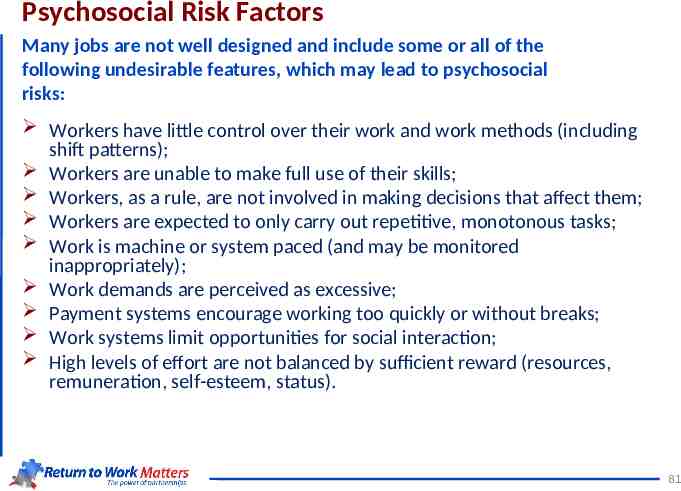
Psychosocial Risk Factors Many jobs are not well designed and include some or all of the following undesirable features, which may lead to psychosocial risks: Workers have little control over their work and work methods (including shift patterns); Workers are unable to make full use of their skills; Workers, as a rule, are not involved in making decisions that affect them; Workers are expected to only carry out repetitive, monotonous tasks; Work is machine or system paced (and may be monitored inappropriately); Work demands are perceived as excessive; Payment systems encourage working too quickly or without breaks; Work systems limit opportunities for social interaction; High levels of effort are not balanced by sufficient reward (resources, remuneration, self-esteem, status). 81
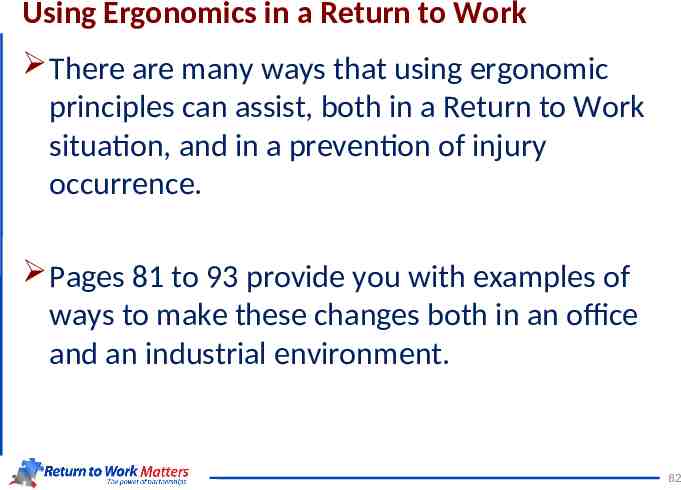
Using Ergonomics in a Return to Work There are many ways that using ergonomic principles can assist, both in a Return to Work situation, and in a prevention of injury occurrence. Pages 81 to 93 provide you with examples of ways to make these changes both in an office and an industrial environment. 82
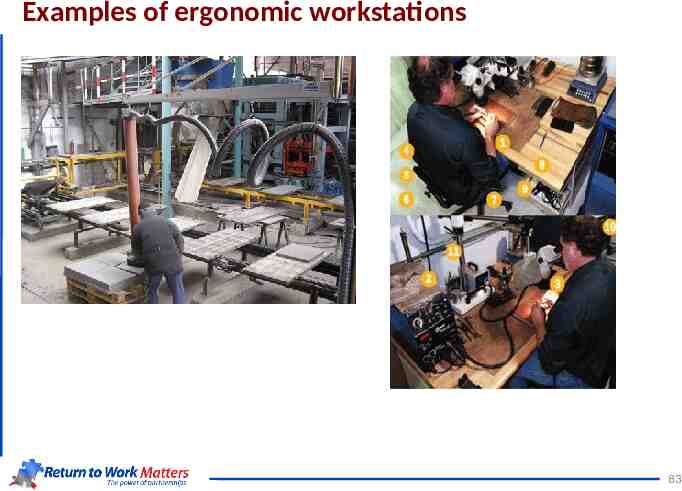
Examples of ergonomic workstations 83
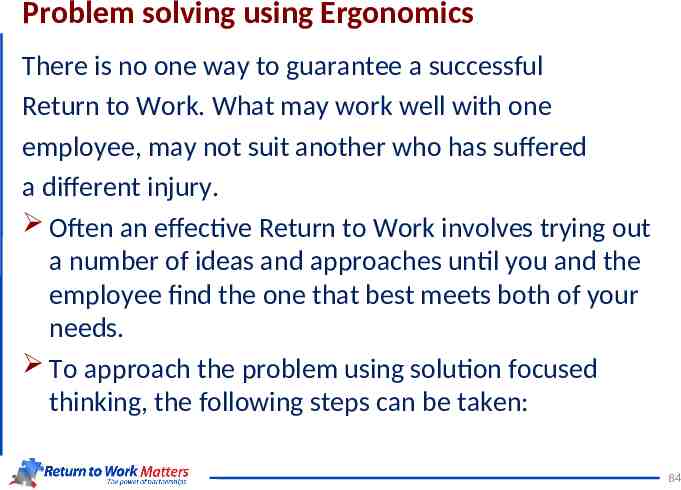
Problem solving using Ergonomics There is no one way to guarantee a successful Return to Work. What may work well with one employee, may not suit another who has suffered a different injury. Often an effective Return to Work involves trying out a number of ideas and approaches until you and the employee find the one that best meets both of your needs. To approach the problem using solution focused thinking, the following steps can be taken: 84
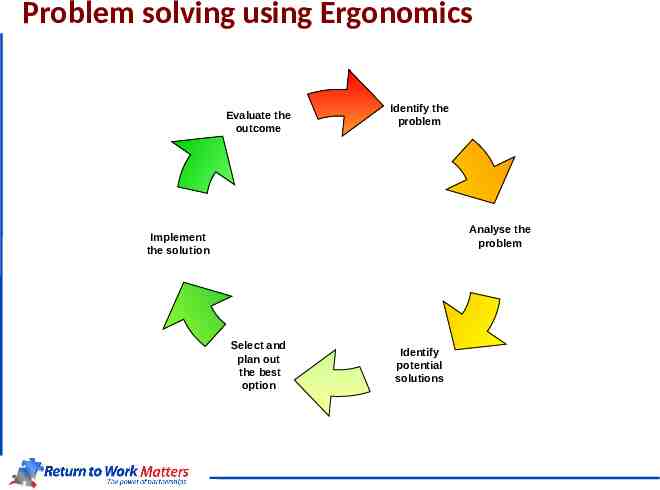
Problem solving using Ergonomics Evaluate the outcome Identify the problem Analyse the problem Implement the solution Select and plan out the best option Identify potential solutions
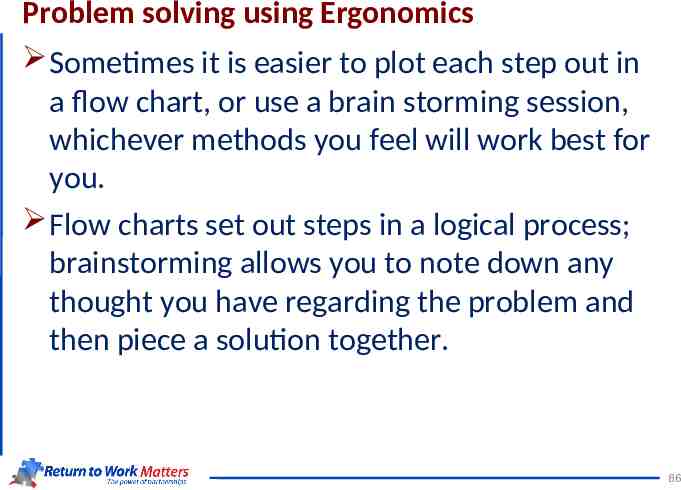
Problem solving using Ergonomics Sometimes it is easier to plot each step out in a flow chart, or use a brain storming session, whichever methods you feel will work best for you. Flow charts set out steps in a logical process; brainstorming allows you to note down any thought you have regarding the problem and then piece a solution together. 86
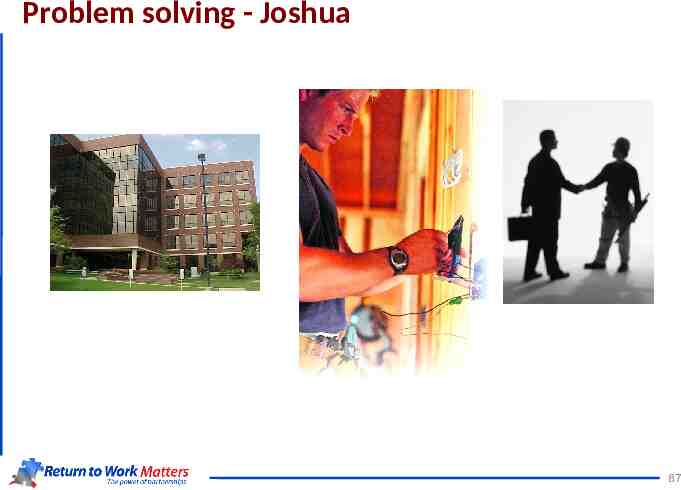
Problem solving - Joshua 87
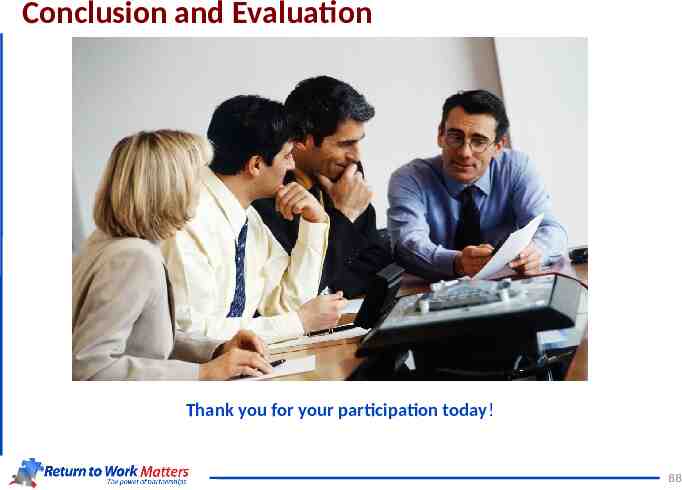
Conclusion and Evaluation Thank you for your participation today! 88






